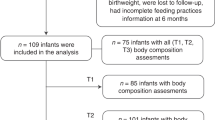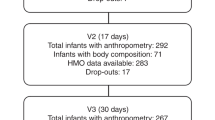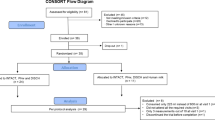Abstract
Objectives:
To evaluate the impact of maternal diet and intensive dietary counselling during pregnancy and breastfeeding on the infant's metabolic status.
Subjects/Methods:
At the first trimester of pregnancy, 256 women were randomized into a control/placebo group and two dietary counselling groups (diet/probiotics and diet/placebo). The counselling, with double-blind randomization to probiotics (Lactobacillus rhamnosus GG and Bifidobacterium lactis) or placebo, targeted excessive saturated fat and low fibre consumption. Maternal diet was evaluated repeatedly during pregnancy and postpartum by means of 3 days’ food diaries. Metabolic markers, serum 32–33 split and intact proinsulin, leptin/adiponectin ratio, skinfold thickness and waist circumference were measured of 194 healthy infants at the age of 6 months, and the high levels were taken to mirror adverse metabolic status.
Results:
The proportion of infants with a high 32–33 split proinsulin was significantly lower in dietary counselling with probiotics (n=6/62, 9.7%) or placebo (n=7/69, 10.1%) compared with the control/placebo group (n=17/63, 27.0%). The high split proinsulin was associated with larger skinfold thickness, waist circumference and higher leptin/adiponectin ratio in the infants (P<0.05). With respect to maternal diet during pregnancy, the highest and lowest tertiles of fat intake increased the infant’s risk of high split proinsulin, whereas those of butter associated correspondingly with the infant's waist circumference. Further, breastfed infants showed a reduced risk of high split proinsulin and leptin/adiponectin ratio compared with formula-fed infants.
Conclusions:
Modification of maternal diet during pregnancy and breastfeeding may benefit infant metabolic health. High split proinsulin reflects adverse metabolic status in infancy, which can be improved by early dietary counselling.
This is a preview of subscription content, access via your institution
Access options
Subscribe to this journal
Receive 12 print issues and online access
$259.00 per year
only $21.58 per issue
Buy this article
- Purchase on Springer Link
- Instant access to full article PDF
Prices may be subject to local taxes which are calculated during checkout


Similar content being viewed by others
References
Aaltonen J, Ojala T, Laitinen K, Piirainen TJ, Poussa TA, Isolauri E (2008). Evidence of infant blood pressure programming by maternal nutrition during pregnancy: a prospective randomized controlled intervention study. J Pediatr 152, 79–84.
Armstrong J, Reilly JJ (2002). Breastfeeding and lowering the risk of childhood obesity. Lancet 359, 2003–2004.
Barker DJ (2004). The developmental origins of chronic adult disease. Acta Paediatr Suppl 93, 26–33.
Becker W, Lyhne N, Pedersen AN, Aro A, Fogelholm M, Phòrsdottir I et al. (2004). Nordic nutrition recommendations 2004 - integrating nutrition and physical activity. Scan J Nutr 48, 178–187.
Boney CM, Verma A, Tucker R, Vohr BR (2005). Metabolic syndrome in childhood: association with birth weight, maternal obesity, and gestational diabetes mellitus. Pediatrics 115, e290–e296.
Cani PD, Neyrinck AM, Fava F, Knauf C, Burcelin RG, Tuohy KM et al. (2007). Selective increases of bifidobacteria in gut microflora improve high-fat-diet-induced diabetes in mice through a mechanism associated with endotoxaemia. Diabetologia 50, 2374–2383.
Corvalan C, Uauy R, Kain J, Martorell R (2010). Obesity indicators and cardiometabolic status in 4-y-old children. Am J Clin Nutr 91, 166–174.
Darendeliler F, Poyrazoglu S, Sancakli O, Bas F, Gokcay G, Aki S et al. (2009). Adiponectin is an indicator of insulin resistance in non-obese prepubertal children born large for gestational age (LGA) and is affected by birth weight. Clin Endocrinol (Oxf) 70, 710–716.
Fanaro S, Chierici R, Guerrini P, Vigi V (2003). Intestinal microflora in early infancy: composition and development. Acta Paediatr Suppl 91, 48–55.
Fantuzzi G (2005). Adipose tissue, adipokines, and inflammation. J Allergy Clin Immunol 115, 911–919; quiz 920.
Gil-Campos M, Aguilera CM, Ramirez-Tortosa MC, Canete R, Gil A (2010). Fasting and postprandial relationships among plasma leptin, ghrelin, and insulin in prepubertal obese children. Clin Nutr 29, 54–59.
Glauber HS, Revers RR, Henry R, Schmeiser L, Wallace P, Kolterman OG et al. (1986). In vivo deactivation of proinsulin action on glucose disposal and hepatic glucose production in normal man. Diabetes 35, 311–317.
Godfrey K, Robinson S, Barker DJ, Osmond C, Cox V (1996). Maternal nutrition in early and late pregnancy in relation to placental and fetal growth. BMJ 312, 410–414.
Griffiths EA, Duffy LC, Schanbacher FL, Qiao H, Dryja D, Leavens A et al. (2004). In vivo effects of bifidobacteria and lactoferrin on gut endotoxin concentration and mucosal immunity in Balb/c mice. Dig Dis Sci 49, 579–589.
Guarner F, Malagelada JR (2003). Gut flora in health and disease. Lancet 361, 512–519.
Hales CN, Barker DJ, Clark PM, Cox LJ, Fall C, Osmond C et al. (1991). Fetal and infant growth and impaired glucose tolerance at age 64. BMJ 303, 1019–1022.
Hanley AJ, McKeown-Eyssen G, Harris SB, Hegele RA, Wolever TM, Kwan J et al. (2002). Cross-sectional and prospective associations between abdominal adiposity and proinsulin concentration. J Clin Endocrinol Metab 87, 77–83.
Hawdon JM, Aynsley-Green A, Alberti KG, Ward Platt MP (1993). The role of pancreatic insulin secretion in neonatal glucoregulation. I. Healthy term and preterm infants. Arch Dis Child 68, 274–279.
Howarth NC, Saltzman E, Roberts SB (2001). Dietary fiber and weight regulation. Nutr Rev 59, 129–139.
Ilmonen J, Isolauri E, Poussa T, Laitinen K (2010). Impact of dietary counselling and probiotic intervention on maternal anthropometric measurements during and after pregnancy: a randomized placebo-controlled trial. Clin Nutr (in press).
Institute of Medicine, Subcommittee on Nutritional Status and Weight Gain During Pregnancy (1990). Nutrition During Pregnancy. National Academy Press: Washington, DC.
Jones RH, Ozanne SE (2009). Fetal programming of glucose-insulin metabolism. Mol Cell Endocrinol 297, 4–9.
Karlsson FA, Engstrom BE, Lind L, Ohrvall M (2004). No postprandial increase of plasma adiponectin in obese subjects. Obes Res 12, 1031–1032.
Laitinen K, Hoppu U, Hamalainen M, Linderborg K, Moilanen E, Isolauri E (2006). Breast milk fatty acids may link innate and adaptive immune regulation: analysis of soluble CD14, prostaglandin E2, and fatty acids. Pediatr Res 59, 723–727.
Laitinen K, Poussa T, Isolauri E (2009). Probiotics and dietary counselling contribute to glucose regulation during and after pregnancy: a randomised controlled trial. Br J Nutr 101, 1679–1687.
Luoto R, Laitinen K, Nermes M, Isolauri E (2010). Impact of maternal probiotic-supplemented dietary counselling on pregnancy outcome and prenatal and postnatal growth: a double-blind, placebo-controlled study. Br J Nutr 103, 1792–1799.
Mantzoros CS, Rifas-Shiman SL, Williams CJ, Fargnoli JL, Kelesidis T, Gillman MW (2009). Cord blood leptin and adiponectin as predictors of adiposity in children at 3 years of age: a prospective cohort study. Pediatrics 123, 682–689.
Mikkelsen TB, Osler M, Orozova-Bekkevold I, Knudsen VK, Olsen SF (2006). Association between fruit and vegetable consumption and birth weight: a prospective study among 43 585 Danish women. Scand J Public Health 34, 616–622.
Moses RG, Luebcke M, Davis WS, Coleman KJ, Tapsell LC, Petocz P et al. (2006). Effect of a low-glycemic-index diet during pregnancy on obstetric outcomes. Am J Clin Nutr 84, 807–812.
Mykkanen L, Haffner SM, Hales CN, Ronnemaa T, Laakso M (1997). The relation of proinsulin, insulin, and proinsulin-to-insulin ratio to insulin sensitivity and acute insulin response in normoglycemic subjects. Diabetes 46, 1990–1995.
Norata GD, Raselli S, Grigore L, Garlaschelli K, Dozio E, Magni P et al. (2007). Leptin:adiponectin ratio is an independent predictor of intima media thickness of the common carotid artery. Stroke 38, 2844–2846.
Nordic Working Group on Diet and Nutrition (1996). Nordic nutritional recommendations. Scand J Nutr 40, 161–165.
Painter RC, de Rooij SR, Bossuyt PM, Simmers TA, Osmond C, Barker DJ et al. (2006). Early onset of coronary artery disease after prenatal exposure to the Dutch famine. Am J Clin Nutr 84, 322–327.
Piirainen T, Isolauri E, Lagstrom H, Laitinen K (2006). Impact of dietary counselling on nutrient intake during pregnancy: a prospective cohort study. Br J Nutr 96, 1095–1104.
Ravelli ACJ, van der Meulen JHP, Michaels RPJ, Osmond C, Barker DJP, Hales CN et al. (1998). Glucose tolerance in adults after prenatal exposure to famine. Lancet 351, 173–177.
Rinne M, Kalliomaki M, Arvilommi H, Salminen S, Isolauri E (2005). Effect of probiotics and breastfeeding on the bifidobacterium and lactobacillus/enterococcus microbiota and humoral immune responses. J Pediatr 147, 186–191.
Riserus U, Willett WC, Hu FB (2009). Dietary fats and prevention of type 2 diabetes. Prog Lipid Res 48, 44–51.
Schubring C, Siebler T, Kratzsch J, Englaro P, Blum WF, Triep K et al. (1999). Leptin serum concentrations in healthy neonates within the first week of life: relation to insulin and growth hormone levels, skinfold thickness, body mass index and weight. Clin Endocrinol (Oxf) 51, 199–204.
Semple RK, Soos MA, Luan J, Mitchell CS, Wilson JC, Gurnell M et al. (2006). Elevated plasma adiponectin in humans with genetically defective insulin receptors. J Clin Endocrinol Metab 91, 3219–3223.
Shea S, Aymong E, Zybert P, Shamoon H, Tracy RP, Deckelbaum RJ et al. (2003). Obesity, fasting plasma insulin, and C-reactive protein levels in healthy children. Obes Res 11, 95–103.
Shiell AW, Campbell DM, Hall MH, Barker DJ (2000). Diet in late pregnancy and glucose-insulin metabolism of the offspring 40 years later. BJOG 107, 890–895.
Shoelson SE, Lee J, Goldfine AB (2006). Inflammation and insulin resistance. J Clin Invest 116, 1793–1801.
Singhal A, Fewtrell M, Cole TJ, Lucas A (2003). Low Nutrient intake and early growth for later insulin resistance in adolescents born preterm. Lancet 361, 1089–1097.
Steinberger J, Steffen L, Jacobs Jr DR, Moran A, Hong CP, Sinaiko AR (2003). Relation of leptin to insulin resistance syndrome in children. Obes Res 11, 1124–1130.
Taveras EM, Rifas-Shiman SL, Belfort MB, Kleinman KP, Oken E, Gillman MW (2009). Weight status in the first 6 months of life and obesity at 3 years of age. Pediatrics 123, 1177–1183.
Temple RC, Carrington CA, Luzio SD, Owens DR, Schneider AE, Sobey WJ et al. (1989). Insulin deficiency in non-insulin-dependent diabetes. Lancet 1, 293–295.
Valle M, Gascon F, Martos R, Bermudo F, Caballos P, Suanes A (2003). Relationship between high plasma leptin concentrations and metabolic syndrome in obese pre-pubertal children. Int J Obes Relat Metab Disord 27, 13–18.
Wrotniak BH, Shults J, Butts S, Stettler N (2008). Gestational weight gain and risk of overweight in the offspring at age 7 y in a multicenter, multiethnic cohort study. Am J Clin Nutr 87, 1818–1824.
Zhang C, Liu S, Solomon CG, Hu FB (2006). Dietary fiber intake, dietary glycemic load, and the risk for gestational diabetes mellitus. Diabetes Care 29, 2223–2230.
Acknowledgements
We thank the NIHR Biomedical Research Centre Cambridge and Core Biochemistry Assay Laboratory for proinsulin, leptin and adiponectin measurements, Dr Anu Huurre and Ms Ulla-Maija Eriksson for their contribution in contacting the study subjects, Ms Satu Leinonen for assistance in sample procedures and Mr Robert MacGilleon for revision of the English text. This study was supported by grants from the Social Insurance Institution of Finland, the Sigrid Juselius Foundation, the Yrjö Jahnsson Foundation, the Juho Vainio Foundation (JA), the Varsinais-Suomi Regional Fund of the Finnish Cultural Foundation (JA) and the Emil Aaltonen Foundation (JA). Food products were donated by Raisio plc (Raisio, Finland), L. rhamnosus GG by Valio Ltd (Helsinki, Finland) and B. lactis by Chr. Hansen (Hoersholm, Denmark).
Author information
Authors and Affiliations
Corresponding author
Ethics declarations
Competing interests
The authors declare no conflict of interest.
Rights and permissions
About this article
Cite this article
Aaltonen, J., Ojala, T., Laitinen, K. et al. Impact of maternal diet during pregnancy and breastfeeding on infant metabolic programming: a prospective randomized controlled study. Eur J Clin Nutr 65, 10–19 (2011). https://doi.org/10.1038/ejcn.2010.225
Received:
Revised:
Accepted:
Published:
Issue Date:
DOI: https://doi.org/10.1038/ejcn.2010.225
Keywords
This article is cited by
-
Improving pregnant women’s diet and physical activity behaviours: the emergent role of health identity
BMC Pregnancy and Childbirth (2020)
-
Perinatal nutrition impacts on the functional development of the visual tract in infants
Pediatric Research (2019)
-
Relationship between the lipid composition of maternal plasma and infant plasma through breast milk
Metabolomics (2019)
-
Characterization, the Antioxidant and Antimicrobial Activity of Exopolysaccharide Isolated from Poultry Origin Lactobacilli
Probiotics and Antimicrobial Proteins (2019)
-
Early feeding and risk of Juvenile idiopathic arthritis: a case control study in a prospective birth cohort
Pediatric Rheumatology (2017)



